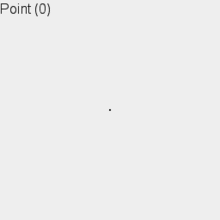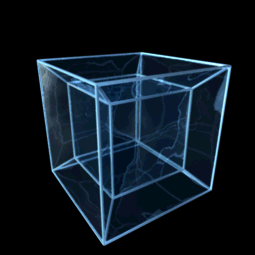Hypercube
In geometry, a hypercube is an n-dimensional analogue of a square (n = 2) and a cube (n = 3); the special case for n = 4 is known as a tesseract.It is a closed, compact, convex figure whose 1-skeleton consists of groups of opposite parallel line segments aligned in each of the space's dimensions, perpendicular to each other and of the same length.A unit hypercube's longest diagonal in n dimensions is equal to[1][2] The term measure polytope (originally from Elte, 1912)[3] is also used, notably in the work of H. S. M. Coxeter who also labels the hypercubes the γn polytopes.[4] The hypercube is the special case of a hyperrectangle (also called an n-orthotope).This process of sweeping out volumes can be formalized mathematically as a Minkowski sum: the d-dimensional hypercube is the Minkowski sum of d mutually perpendicular unit-length line segments, and is therefore an example of a zonotope.Another unit hypercube, centered at the origin of the ambient space, can be obtained from this one by a translation.points whose vectors of Cartesian coordinates are Here the symbol-dimensional hypercube obtained as the convex hull of the points with coordinatesis also often considered due to the simpler form of its vertex coordinates.This identity can be proven by a simple combinatorial argument: for each of theThese numbers can also be generated by the linear recurrence relation.For example, extending a square via its 4 vertices adds one extra line segment (edge) per vertex.Adding the opposite square to form a cube providesThe extended f-vector for an n-cube can also be computed by expanding(concisely, (2,1)n), and reading off the coefficients of the resulting polynomial.An n-cube can be projected inside a regular 2n-gonal polygon by a skew orthogonal projection, shown here from the line segment to the 16-cube.The hypercubes are one of the few families of regular polytopes that are represented in any number of dimensions.A fourth family, the infinite tessellations of hypercubes, is labeled as δn.Another related family of semiregular and uniform polytopes is the demihypercubes, which are constructed from hypercubes with alternate vertices deleted and simplex facets added in the gaps, labeled as hγn.n-cubes can be combined with their duals (the cross-polytopes) to form compound polytopes: The graph of the n-hypercube's edges is isomorphic to the Hasse diagram of the (n−1)-simplex's face lattice.Each vertex connected to the top vertex then uniquely maps to one of the (n−1)-simplex's facets (n−2 faces), and each vertex connected to those vertices maps to one of the simplex's n−3 faces, and so forth, and the vertices connected to the bottom vertex map to the simplex's vertices.This relation may be used to generate the face lattice of an (n−1)-simplex efficiently, since face lattice enumeration algorithms applicable to general polytopes are more computationally expensive.Regular complex polytopes can be defined in complex Hilbert space called generalized hypercubes, γpn = p{4}2{3}...2{3}2, or ... Real solutions exist with p = 2, i.e. γ2n = γn = 2{4}2{3}...2{3}2 = {4,3,..,3}.The facets are generalized (n−1)-cube and the vertex figure are regular simplexes.The generalized squares (n = 2) are shown with edges outlined as red and blue alternating color p-edges, while the higher n-cubes are drawn with black outlined p-edges.The number of m-face elements in a p-generalized n-cube are:Similarly, the exponent 3 will yield a perfect cube, an integer which can be arranged into a cube shape with a side length of the base.As a result, the act of raising a number to 2 or 3 is more commonly referred to as "squaring" and "cubing", respectively.However, the names of higher-order hypercubes do not appear to be in common use for higher powers.
Hypercube (disambiguation)perspective projectionstesseractgeometryn-dimensionalsquareclosedcompactconvexskeletonparallelline segmentsdimensionsperpendicularH. S. M. CoxeterhyperrectangleMinkowski sumzonotopehypercube graphrotatingconvex hullCartesian coordinatesverticescartesian productintervaltranslationfactorialrecurrence relationf-vectorSchläfliCoxeterVertexLine segment5-cube6-cube7-cube8-cube9-cube10-cubePetrie polygonOrthographic projections11-cube12-cube13-cube14-cube15-cuberegular polytopesregular polytopecross-polytopessimplicesinfinite tessellations of hypercubesuniform polytopesdemihypercubessimplexoctagrammiccompound of cube and octahedronisomorphicHasse diagramcomplexHilbert spacevertex figuresimplexesregular polygon{4,3,3}{4,3,3,3}{4,3,3,3,3}{4,3,3,3,3,3}{4,3,3,3,3,3,3}figurate numbersquare numbersquaringHyperoctahedral groupHypersphereCrucifixion (Corpus Hypercubus)University of GroningenCambridge University PressBowen, J. P.Practical ComputingCoxeter, H. S. M.John Wiley & SonsGray codeVeitch diagramKarnaugh mapWeisstein, Eric W.MathWorldWolfram Demonstrations ProjectDimensionVector spaceEuclidean spaceAffine spaceProjective spaceFree moduleManifoldAlgebraic varietySpacetimeLebesgue coveringInductiveHausdorffMinkowskiFractalDegrees of freedomPolytopesshapesHyperplaneHypersurfaceDemihypercubeCross-polytopeHyperpyramidHypercomplex numbersCayley–Dickson constructionn-dimensionsHyperspaceCodimensionregularTriangleHexagonPentagonUniform polyhedronTetrahedronOctahedronDemicubeDodecahedronIcosahedronUniform polychoronPentachoron16-cell

